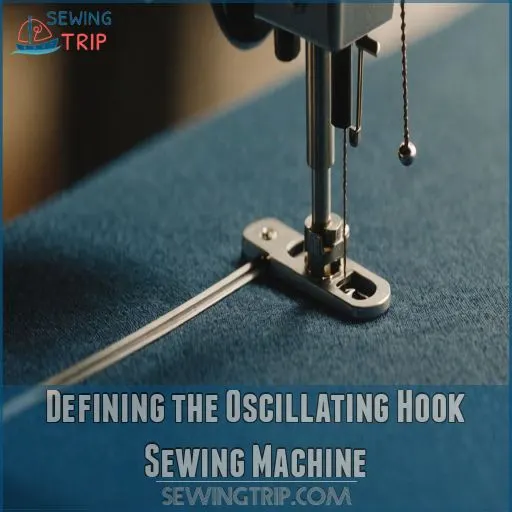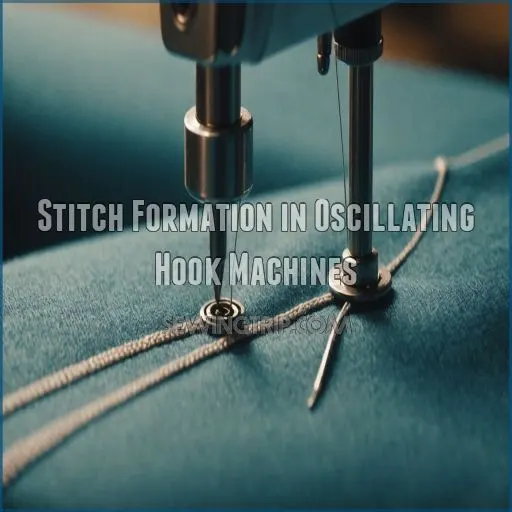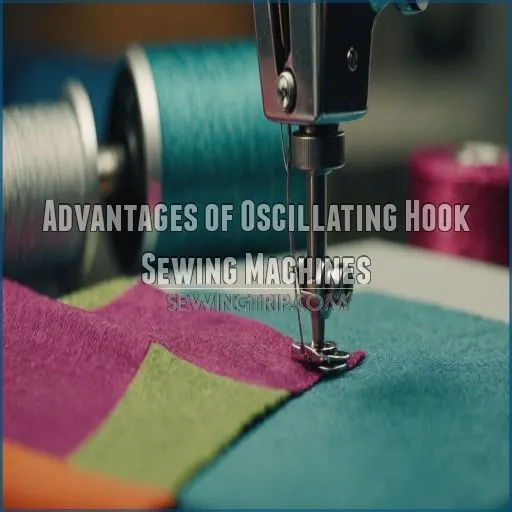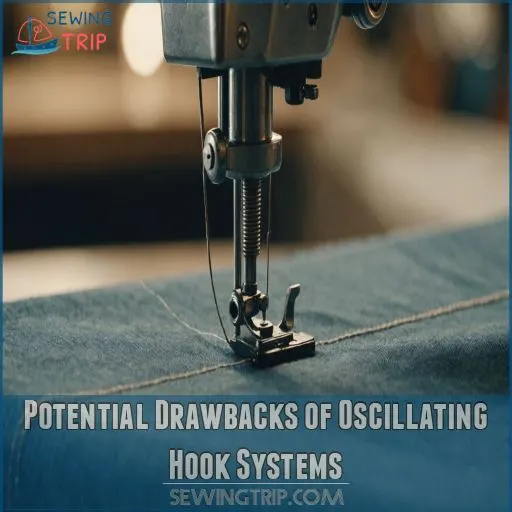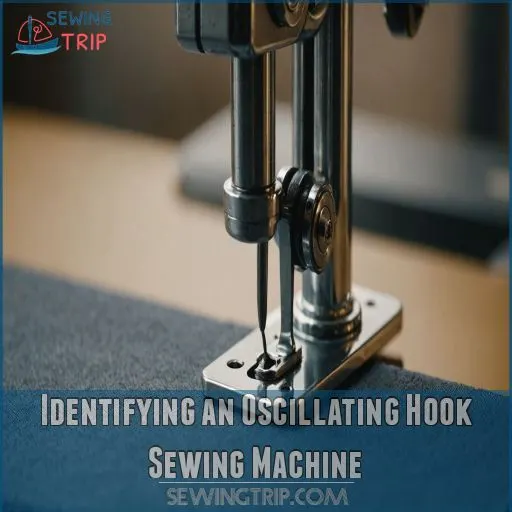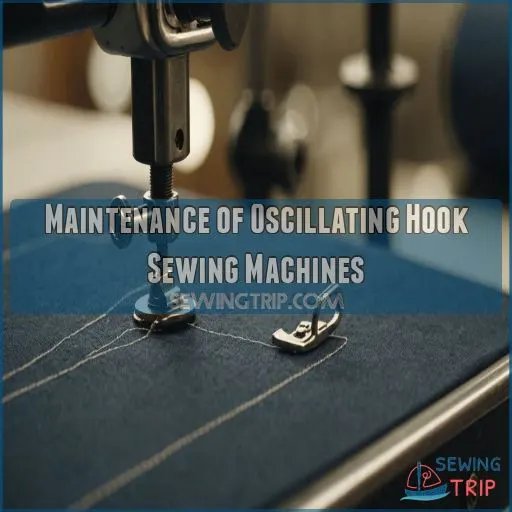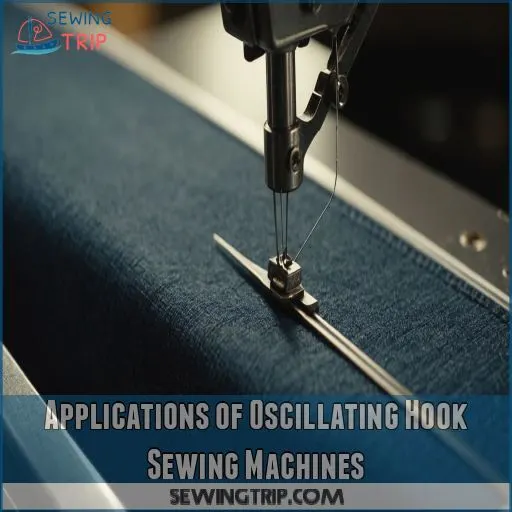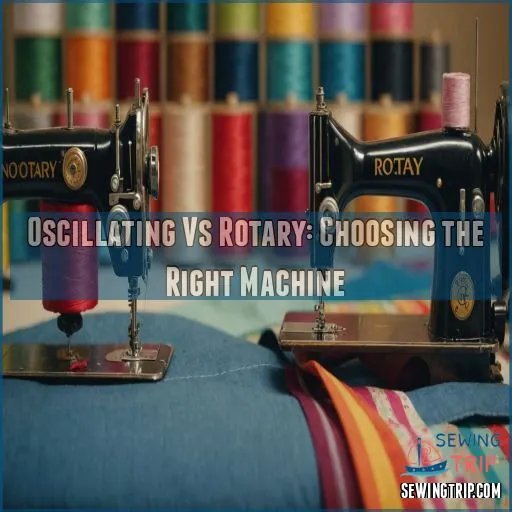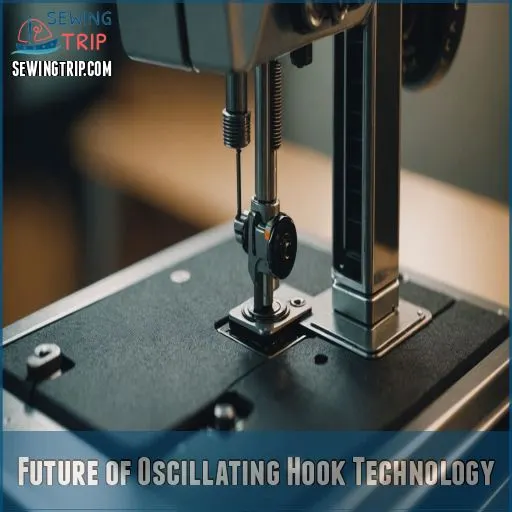This site is supported by our readers. We may earn a commission, at no cost to you, if you purchase through links.
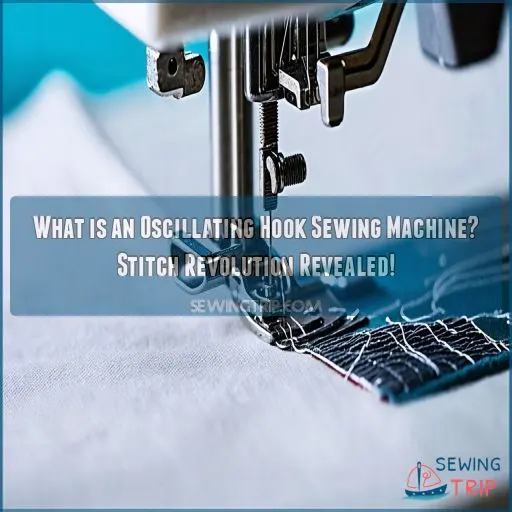
Unlike its spinning cousin, the rotary hook, this bad boy swings back and forth like a pendulum. It catches the upper thread, swings it around the bobbin, then reverses course – all in perfect sync with the needle.
You’ll love its simplicity and knack for handling thicker threads, but it might not win any races against speedier models. It’s like the tortoise of the sewing world: slow, but it gets the job done.
Curious about mastering this mechanical marvel? There’s a whole world of stitching secrets waiting to be unraveled.
Table Of Contents
- Key Takeaways
- Defining the Oscillating Hook Sewing Machine
- The Oscillating Hook’s Movement Pattern
- Stitch Formation in Oscillating Hook Machines
- Advantages of Oscillating Hook Sewing Machines
- Potential Drawbacks of Oscillating Hook Systems
- Identifying an Oscillating Hook Sewing Machine
- Maintenance of Oscillating Hook Sewing Machines
- Applications of Oscillating Hook Sewing Machines
- Oscillating Vs Rotary: Choosing the Right Machine
- Future of Oscillating Hook Technology
- Frequently Asked Questions (FAQs)
- Conclusion
Key Takeaways
- You’ll find that oscillating hook sewing machines are the tortoises of the sewing world—they may not be the speediest, but they’re reliable workhorses that will handle everything from delicate silks to tough denim without breaking a sweat.
- These machines are a breeze to maintain—with fewer moving parts than their rotary cousins, you’ll spend less time tinkering and more time creating. It’s like having a low-maintenance pet that still does tricks.
- While they might not win any races, oscillating hook machines are masters of versatility. They’re like the Swiss Army knives of sewing, adapting to different thread types and fabric weights with ease.
- As technology advances, you’ll see these old-school champs getting high-tech makeovers. Imagine controlling your stitches from your phone or having a machine that adjusts tension on its own—it’s like giving your trusty sewing companion a Ph.D. in modern tech.
Defining the Oscillating Hook Sewing Machine
Ever wondered how your trusty sewing machine creates those perfect stitches with precise sewing machine timing
?
An oscillating hook sewing machine uses a back-and-forth motion to catch the upper thread and wrap it around the properly threaded bobbin
.
Creating a secure lock stitch that’ll keep your seams from unraveling faster than your gran’s sweater stories.
Basic Mechanism of Oscillating Hook
The heart of your sewing machine’s magic lies in its oscillating hook.
Unlike its spinning cousin, this clever little device swings back and forth like a pendulum (Source).
It’s the choreographer of your stitch formation, dancing with the needle to create perfect loops.
As you sew, the hook grabs the upper thread, swoops it around the bobbin, and then reverses course, all in a precise timing sequence.
Key Components of the Machine
Diving into the heart of your oscillating hook machine, you’ll find a symphony of components working in perfect harmony.
The star of the show? Your shuttle hook, swinging back and forth like a metronome. Oscillating hooks like this one are designed for versatility and simplicity, making them suitable for a wide range of materials and thread sizes with ease.
Compared to their rotary hook counterparts, oscillating hooks have fewer parts, are less expensive, and easier to maintain.
It’s joined by the bobbin case, needle bar, feed dog, and take-up lever – each playing a key role in creating that perfect stitch. Think of it as a tiny factory, with each part contributing to your sewing masterpiece!
How It Differs From Other Sewing Machines
You’ll notice the oscillating hook sewing machine’s unique dance. Unlike its rotary cousin, it swings back and forth, not making full circles.
This rhythmic motion affects thread tolerances, allowing for versatility with heavier threads.
While it might be a bit louder and slower than rotary types, it’s a cinch to maintain . Think of it as the steady tortoise in the sewing race.
The Oscillating Hook’s Movement Pattern
You’re about to unravel the mesmerizing dance of the oscillating hook.
Watch as it swings back and forth, partnering with the needle in a perfectly timed tango to create your stitches.
Step-by-step Description of Hook Motion
Now that you’ve got the basics down, let’s waltz through the hook’s fancy footwork. Imagine this: your oscillating hook‘s doing the cha-cha with your thread!
- Hook snags the upper thread loop
- Swings it halfway ’round the bobbin
- Reverses direction like it forgot its keys
- Returns home, ready for an encore
This back-and-forth dance is what sets oscillating hooks apart from their rotary cousins.
Timing and Synchronization With Needle
The heartbeat of your sewing machine lies in its timing.
Your oscillating hook and needle must dance in perfect harmony, like synchronized swimmers. When they’re in step, you’ll create flawless stitches.
But if they’re off, you’ll face a tangled mess faster than you can say "bobbin."
Remember, proper synchronization is key to avoiding timing errors and ensuring your machine purrs like a well-oiled kitten, with flawless stitches.
Comparison With Rotary Hook Movement
In sewing machines, the oscillating hook dances to a different rhythm than its rotary cousin. While both aim for perfect stitch formation, their movements are as different as night and day.
Let’s explore the differences:
- Motion madness: Oscillating hooks play ping-pong, while rotary hooks spin like a merry-go-round.
- Speed demons: Rotary hooks zoom faster, leaving oscillating hooks in the dust.
- Vibration vacation: Rotary hooks offer a smoother ride, with less shake and rattle.
- Thread tolerance: Oscillating hooks are more forgiving, perfect for your experimental thread adventures.
Stitch Formation in Oscillating Hook Machines
You’re about to uncover the magic behind oscillating hook sewing machines.
Watch as the hook dances back and forth, snagging the upper thread and guiding it down to tango with the bobbin, creating a perfect lock stitch every time.
Thread Pick-up Process
Imagine this: you’re threading the eye of a needle, ready to create magic.
As your oscillating hook machine whirs to life, it’s showtime for the thread pick-up process.
Your needle plunges through the fabric, carrying its precious thread cargo.
As it rises, a loop forms in the needle’s scarf – that’s your cue.
The oscillating hook, like a skilled dancer, swoops in to catch this loop, setting the stage for stitch formation .
Loop Formation Around the Bobbin
Ever wondered how your trusty oscillating hook sewing machine works its magic?
As the needle rises, it forms a loop that’s snatched by the oscillating hook’s point.
This dance of thread and metal is like a well-choreographed tango.
The hook swings the loop around the bobbin, creating a delicate embrace between top and bottom threads.
It’s a stitch revolution in miniature!
Completing the Lock Stitch
You’ve watched the loop form around the bobbin, now it’s time for the grand finale.
The rotating shuttle hook, a key component in the Bobbin and Shuttle Mechanism, catches this loop around the lower thread, forming an unbreakable knot when pulled tight by the machine’s motor power.
As the needle rises, it pulls the thread tight, creating that perfect lock stitch, similar to how the dog mechanism moves fabric through the machine at a steady speed, ensuring each stitch is of equal length.
It’s like tying the world’s tiniest knot, over and over again.
Your oscillating hook sewing machine is working its magic, ensuring each stitch is secure and uniform. Talk about stitch quality revolution!
Advantages of Oscillating Hook Sewing Machines
You’re about to discover why oscillating hook sewing machines are a favorite among sewers of all skill levels.
These machines offer a trifecta of benefits.
These benefits include simplicity in design, ease of maintenance, and versatility in handling different thread types, making them a smart choice for your sewing adventures.
Simplicity in Design and Operation
The beauty of oscillating hook sewing machines lies in their straightforward design. You’ll find them incredibly beginner-friendly, with an intuitive setup that’ll have you stitching like a pro in no time.
The oscillating hook’s simple movement makes threading a breeze, and you’ll love how easily you can adjust tension.
It’s like having a sewing buddy that speaks your language, making your crafting journey smooth sailing from day one.
Ease of Maintenance and Repair
Explore the world of oscillating hook sewing machines, where maintenance is a breeze!
You’ll love how simple it’s to keep these workhorses humming. With fewer moving parts than their rotary cousins, troubleshooting common issues becomes a cinch.
Whether you’re cleaning your apollo bobbin or polishing the needle bar to a glass-like finish, DIY repair tips abound.
Long-term durability? You bet! These machines are built to last, making them a stitch above the rest.
Versatility in Handling Different Thread Types
Oscillating hook sewing machines aren’t just easy to maintain – they’re thread virtuosos. You’ll love their versatility with different thread types.
These nimble machines handle a variety of threads thanks to the shuttle hook‘s ability to facilitate smooth fabric movement. With the shuttle hook’s precise thread cuts and tension control working in harmony, you’ll be able to tackle a wide range of sewing projects.
- Thread size tolerance that’ll make you feel like Goldilocks finding the perfect fit
- Thread weight impact as smooth as butter on a hot toast
- Thread tension control tighter than your grandma’s purse strings
With this hook system, you’re the master of your sewing destiny!
Potential Drawbacks of Oscillating Hook Systems
While oscillating hook sewing machines offer simplicity and versatility, they’re not without their quirks.
They have some notable drawbacks – they’re a bit noisier and slower than their rotary counterparts.
They might struggle with precision at higher speeds – kind of like trying to write neatly while riding a bumpy bus.
Noise and Vibration Levels
Ever wondered why your oscillating hook sewing machine sounds like a tiny jackhammer? You’re not alone!
While these machines are workhorses, they can be noisy neighbors.
The hook’s back-and-forth motion creates vibrations that can shake your table and your nerves.
But don’t throw in the towel just yet! Try placing a no-slip shelf liner under your machine to dampen vibrations and reduce noise .
Your ears (and neighbors) will thank you!
Speed Limitations Compared to Rotary Systems
You’ve mastered the noise, but now let’s talk speed. While oscillating hooks are the tortoise in this race, rotary hooks are the hare. Your oscillating buddy tops out at about 1600 stitches per minute, while rotary systems can zoom past that limit.
- Oscillating hooks reverse momentum with each stitch
- This back-and-forth motion creates more resistance
- Extra strain caps the maximum speed
Don’t fret, though! For most home sewers, this speed difference is barely noticeable.
Precision in Stitching at High Speeds
When pedal meets metal, your oscillating hook machine might start to sweat.
At high speeds, stitch consistency can become as unpredictable as a cat on a hot tin roof.
You’ll face speed limitations that make you feel like you’re stuck in sewing rush hour.
Thread tension goes haywire, vibrations turn your workspace into a mini earthquake, and needle timing becomes a delicate dance.
It’s like trying to thread a needle on a rollercoaster!
Identifying an Oscillating Hook Sewing Machine
You’ll spot an oscillating hook sewing machine by its unique back-and-forth motion, visible when you peek under the hood.
Check the specs or watch the hook in action – if it’s doing a little dance instead of spinning in circles, you’ve got yourself an oscillating hook machine.
Visual Cues and Characteristics
Spotting an oscillating hook sewing machine isn’t rocket science, but it’s like finding a needle in a haystack if you don’t know what to look for. Let’s sharpen your eye! The bobbin case shape is your first clue – it’s typically more rounded than its rotary counterparts. You’ll also notice a unique thread path that accommodates the back-and-forth motion.
- The thrill of uncovering a hidden gem in your sewing room
- The satisfaction of mastering machine identification like a pro
- The excitement of discovering new creative possibilities with your newfound knowledge
Checking the Machine’s Specifications
Let’s take a closer look at the specs of your sewing machine – it’s like decoding a secret language!
Check the manual for the hook type; oscillating hooks are your ticket to heavy-duty sewing.
Look for bobbin size (likely class 66) (Source), stitch options, and speed range.
Don’t forget thread tolerance – oscillating hooks can handle thicker threads like a champ. It’s all about finding your perfect match!
Observing the Hook’s Movement
As you peek under the hood of your sewing machine, you’ll discover the secret of its oscillating heart.
The hook’s dance is a dead giveaway – it swings back and forth like a metronome, never completing a full rotation.
This half-moon waltz, about 200 degrees of motion, is the telltale sign you’re dealing with an oscillating.
It’s like watching a tiny, metallic pendulum at work!
Maintenance of Oscillating Hook Sewing Machines
You’ll need to keep your oscillating hook sewing machine in tip-top shape to make sure it keeps stitching like a dream.
Regular cleaning, oiling, and tension adjustments are your secret weapons against the "bird’s nest" under your fabric.
So let’s roll up our sleeves and get your trusty machine purring like a well-oiled kitten.
Cleaning the Hook and Bobbin Area
Now that you’ve identified your oscillating hook sewing machine, it’s time to tackle the nitty-gritty: cleaning the hook and bobbin area. Think of it as giving your machine a spa day!
- Unplug your machine (safety first, folks!)
- Remove the bobbin and case
- Use a clean 1/2" paintbrush to flick out lint.
Remember, a clean machine is a happy machine! You should be sewing like a pro in no time!
Lubricating the Oscillating Mechanism
The oscillating mechanism is the heart of your sewing machine, and keeping it well-oiled is like giving it a spa day! You’ll want to lubricate it regularly to keep your stitches smooth as butter.
| Task | Task | Details |
|---|---|---|
| Lubricant types | Sewing machine oil | |
| Frequency | Every 8-10 hours of use | |
| Tools needed | Oil can, lint-free cloth | |
| Signs of wear | Squeaking, stiff movement | |
| Maintenance schedule | Weekly check, monthly deep clean |
Remember, a well-oiled machine is a happy machine!
Adjusting Tension and Timing
Your sewing machine’s tension dance can be a real head-scratcher, especially when it comes to mastering thread tension secrets sewing machine tension fixing
. Troubleshooting tension issues starts with checking your needle size and thread. Don’t forget to inspect the bobbin compartment for any debris and make sure the bobbin is inserted properly, as this can also affect the tension a clean bobbin compartment.
Matching the thread type and tension is also very important to maintaining seam quality.
For timing adjustments, remember: when the needle’s on its way up, the hook should meet it just above the eye. Don’t forget to verify the clutch engagement before diving into timing tweaks.
Master these steps, and you’ll be stitching like a pro in no time!
Applications of Oscillating Hook Sewing Machines
You’ll find oscillating hook sewing machines tackling a wide range of fabrics and projects, from delicate silks to sturdy denim.
These versatile workhorses are go-to tools in industries like fashion, upholstery, and automotive manufacturing.
They’re proving they’re not just for your grandma’s quilting circles anymore, instead serving as essential tools in various industries.
Ideal Fabric Types for Oscillating Hooks
While oscillating hook sewing machines can handle a variety of fabrics, they’re truly the Swiss Army knife of the sewing world.
You’ll find these versatile machines ready to tackle:
- Lightweight fabrics: Delicate silks and chiffons
- Medium-weight fabrics: Your everyday cotton and linen
- Heavy fabrics: Denim and canvas, no sweat
- Knit and woven fabrics: From t-shirt material to upholstery
Don’t let the back-and-forth motion fool you – these hooks are fabric chameleons, adapting to whatever you throw their way.
Suitable Sewing Projects and Techniques
Ready to tackle heavy-duty projects? Oscillating hook machines are your trusty sidekicks for conquering thick fabrics and intricate designs. You’ll breeze through quilting, home decor, and garment sewing like a pro. Embroidery? No sweat! These machines handle heavier threads with ease, perfect for adding pizzazz to your creations.
To get the most out of your oscillating hook machine, it’s important to choose the right bobbin type and size, as consulting the sewing machine manual can help you find the perfect pairings for your specific machine and fabric.
Proper bobbin selection and maintenance can also help prevent hook assembly damage and guarantee a smooth sewing experience.
So, whether you’re stitching up a storm on denim or crafting cozy quilts, your oscillating hook machine’s got your back.
Industries Using Oscillating Hook Machines
From textile production to shoemaking, oscillating hook machines are the unsung heroes of many industries.
You’ll find these workhorses in garment manufacturing, churning out clothes faster than you can say "fashion forward."
They’re also the go-to for leather goods and upholstery, handling heavy-duty materials with ease. Think of them as the Swiss Army knives of the sewing world – versatile, reliable, and ready to tackle any stitching challenge as the Swiss Army knives
Oscillating Vs Rotary: Choosing the Right Machine
You’re faced with an important decision: oscillating or rotary hook for your sewing machine?
Let’s break down the key differences between these two stitch-makers, so you can choose the perfect match for your sewing style and needs.
Comparing Stitch Quality and Consistency
Now, let’s unravel the great stitch debate: oscillating vs. rotary hooks.
You’d think one would clearly outshine the other, but it’s not that cut and dry.
Both create identical lock-stitches , so you can’t judge a book by its cover – or a seam by its hook type!
Stitch tension, seam strength, and stitch density depend more on your machine’s overall quality and your skills than the hook system.
Considering User Skill Level and Needs
While stitch quality is key, your skill level and needs are the real game-changers.
Beginners, you’ll love oscillating hook machines – they’re like sewing with training wheels! (Source) These beginner-friendly machines are a breeze to maintain and won’t throw a tantrum when you switch projects.
For the seasoned pros, rotary hooks offer more bells and whistles, perfect for those who’ve mastered the basics and crave more creative control.
Evaluating Cost and Long-term Value
You’ve mastered your skills, now let’s talk money!
Oscillating hook machines often come with a lower price tag, but don’t be fooled by the upfront savings.
Consider the long game: rotary hooks tend to outlast their oscillating cousins.
While oscillating machines might shake your table more, rotary models often purr along quietly, potentially saving you headaches (and aspirin costs) down the road.
It’s not just about stitches—it’s about stitching smart!
Future of Oscillating Hook Technology
You’ll soon see oscillating hook sewing machines with smart features like touchscreens and Wi-Fi connectivity, making your sewing projects a breeze.
These machines are also getting greener, with energy-saving motors and eco-friendly materials that’ll make you feel good about your crafting hobby.
Integration With Digital Sewing Features
As we move forward, your trusty oscillating hook is getting a high-tech makeover.
Smart sewing features are transforming these machines into digital powerhouses.
Imagine app integration that allows you to control stitches from your phone, or automated features that adjust tension on the fly.
Connected sewing machines mean you’ll never miss a beat, with real-time data on production activities.
It’s like giving your old-school machine a Ph.D. in modern tech!
Sustainability and Energy Efficiency Improvements
Beneath the hum of your trusty oscillating hook sewing machine lies a green revolution!
You’re not just stitching fabric; you’re weaving a sustainable future.
Let’s unravel the eco-friendly upgrades coming to your favorite sewing companion:
- Energy-saving features that’ll make your electricity bill do a happy dance
- Eco-friendly materials giving Mother Nature a high-five
- Recycling initiatives turning old machines into new treasures
- Green manufacturing processes that’ll make your carbon footprint shrink
These innovations aren’t just pie in the sky – they’re the future of sewing!
Frequently Asked Questions (FAQs)
What is the difference between oscillating and rotary bobbins?
Picture a dancer twirling vs. swaying.
Rotary bobbins spin full circles, while oscillating ones rock back and forth.
Rotary’s faster but pickier with thread; oscillating’s more forgiving.
Both create beautiful stitches, so choose based on your sewing style.
What are the different types of sewing machine hooks?
Sewing machines feature two main hook types: rotary and oscillating, particularly useful with various needle sizes compatible with different fabrics
.
Rotary hooks spin 360 degrees, while oscillating hooks rotate partially and reverse.
You’ll also find horizontal and vertical orientations, each with unique benefits for different sewing tasks.
What is the difference between vertical and horizontal hooks on a sewing machine?
Hooks in sewing machines come in vertical or horizontal orientations.
Vertical hooks can load from front, side, or rear, while horizontal hooks require top-loading.
Your preference might depend on bobbin accessibility and whether you want to change it mid-project.
What is the function of the hook on a sewing machine?
Don’t underestimate this tiny part!
The hook’s a real thread-catching ninja.
It grabs the upper thread, loops it around the bobbin, and creates that perfect stitch.
It’s the unsung hero of your sewing machine’s stitching magic.
How does thread tension affect oscillating hook performance?
Thread tension plays a key role in your oscillating hook’s performance.
Too loose, and you’ll see bobbin thread breaks.
Too tight, and you’ll get uneven stitches or even machine jams .
Balance is key for smooth sewing.
Can oscillating hook machines handle heavy-duty sewing tasks?
Oscillating hook machines pack a punch for heavy-duty tasks.
You’ll breeze through thick fabrics like denim and canvas with ease.
Their robust design and powerful motors make them workhorses for tough projects, handling multiple layers without breaking a sweat.
What causes crunching sounds in oscillating hook machines?
Your machine’s crunching sounds might stem from a loose hook driver banging against the hook.
Broken needle pieces in the race can also cause racket.
Check for bent springs or scratched bumps in drop-in bobbins, causing rhythmic thud.
Are oscillating hooks suitable for long, continuous seams?
Sewing machines with oscillating hooks excel at long, continuous seams.
They create low-tension stitches that weave through bulky materials without squeezing.
You’ll find they tame even the trickiest fabrics, making them a seamstress’s secret weapon for marathon sewing sessions.
How to troubleshoot bobbin thread pickup issues?
Tackle bobbin thread visibility issues by first checking the needle’s position and condition understanding bobbin thread
.
Clean the hook area thoroughly, make sure the bobbin is inserted correctly, and verify hook timing.
If issues persist, inspect the bobbin drive gear for damage.
Conclusion
Now you’ve unraveled the mystery of the oscillating hook sewing machine, you’re practically a stitch wizard.
This mechanical marvel mightn’t break any speed records, but it’s a reliable workhorse for your sewing projects.
Whether you’re a seasoned pro or just starting out, understanding "what is an oscillating hook sewing machine" gives you a solid foundation in sewing tech.
So next time you’re stitching away, take a moment to appreciate the humble oscillating hook – it’s quietly revolutionizing your creations, one pendulum swing at a time.

